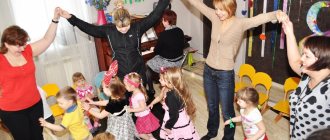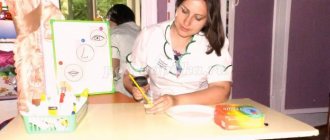MAGAZINE Preschooler.RF
INDIVIDUAL WORK WITH CHILDREN OF JUNIOR PRESCHOOL AGE THROUGH DIDACTIC GAMES(methodological development)
completed by: teacher of the 1st junior group of MBDOU No. 136 Nechukhrina Irina Sergeevna, Murmansk municipal budgetary preschool educational institution of Murmansk, kindergarten No. 136
Relevance:
Formation of cognitive interests and cognitive actions of a preschool child in various types of activities.
Goal: development of cognitive motivation and formation of cognitive actions of younger preschoolers in the process of play activities using didactic games.
Objectives: create conditions for the development of the cognitive abilities of each child and teach him cognitive actions;
- develop children's interest and desire to play educational games, observing the rules and course of the game
- to test a set of didactic games aimed at children’s sensory development
- develop sensory standards
- develop visual-figurative thinking, perception, memory, thinking
- enrich vocabulary:
- promote children's communication with peers and teachers
- increase the level of parental competence in matters of sensory development of children of primary preschool age.
Play is a natural companion in a child’s life, a source of joyful emotions and has great educational power.
Play, the leading activity, plays a huge role in the development and upbringing of a child. A didactic game is one of the types of gaming activities and is an educational game that expands and systematizes ideas about the world around us, influencing the development of curiosity, cognitive processes and abilities of a preschooler
But there are no children with the same habits and behavior, knowledge and skills. All preschoolers have different levels of development. Some are active and fast, others are passive and slow. There are self-confident children, and there are shy ones. To raise such different children and teach them, an individual approach to each child is necessary. It is needed in all types of children's activities and throughout the day.
V.A. Sukhomlinsky wrote: “Somewhere in the innermost corner of the heart, every child has his own string, it sounds in his own way, and in order for the heart to respond to my word, you need to tune in to the tone of this string.”
The essence of the individual approach is to select the means of pedagogical influence on each child individually, taking into account all his abilities, using a didactic game. This approach helps to reveal the individuality of each child.
It is in didactic games that children’s abilities and inclinations are revealed and their individualism is revealed. With appropriate pedagogical guidance, didactic games help enrich the child’s horizons and develop imaginative forms of cognition. Strengthening interests, developing speech, mastering norms of behavior, rules of relationships. The didactic game develops sensory standards, visual and figurative thinking, perception, memory: it promotes children’s communication with peers and teachers.
The educational significance of the didactic game is that it promotes the development of activity, independence and self-confidence in children. An obligatory component of a didactic game are its rules. Rules serve to organize the child’s behavior and actions. Didactic games for children can be divided into three groups: verbal games based on the words and actions of the players. In verbal games, children deepen their knowledge and understanding of objects. In such games, children must independently find signs of similarities and differences between objects, group them according to various properties, describe objects, guess objects from the description.;
- printed board games that children play with enthusiasm. This could be dominoes, paired pictures or lotto. Each game poses various developmental tasks for the child, which he must solve during the game (selection of pictures in pairs, according to a common feature, remembering the composition, number and location of pictures, a story based on the picture showing actions and movements);
- games with objects, in which you can use both toys and real objects. While playing such games, the child compares objects, establishes their similarities and differences. Such games are very important because with their help the child gets acquainted with the characteristics of objects: color, shape, size, learns the properties of objects (soft-hard, wet-dry, etc.) In games with objects, children learn to establish a sequence, compare , classify. Games with natural materials (plant seeds, leaves, pebbles, shells). Games with objects include plot-didactic games and dramatization games.
Knowledge about the individual characteristics of each child helps me to carry out my work successfully.
In individual work with children I use didactic games in the following areas in accordance with the Federal State Educational Standard
Requirements for a subject-specific development environment for individual work with children of primary preschool age: 3-4 years
- The environment should be provided taking into account the individual age characteristics of children, the possibility of communication, physical activity of children, as well as the possibility of privacy.
- The environment should be: content-rich, variable, accessible and safe.
- The organization of individual work should provide: playful, educational, research and creative activity with materials accessible to the child.
- Possibility of varied use of various didactic games, natural materials suitable for use in various types of children's activities, including as substitute objects.
- Variability of the environment involves: using different spaces in individual work with children (for play, construction, privacy), as well as a variety of materials, games, toys and equipment. Providing free choice for children.
- The accessibility of the environment implies; use of didactic games in independent individual activities. Toys, materials, aids that provide all basic types of children's activities.
- Environmental safety involves ensuring reliability and safety in the individual use of educational games.
Contents of the subject-development environment
- Didactic games in accordance with age in all sections of the Program for individual work to consolidate the material.
- Health paths. Sport equipment.
- Pictures on the sound culture of speech, for teaching storytelling, sets of subject pictures; paired
- Collections of pictures on the topics: “What is good” , “What is bad”
- Handout.
- Equipment for individual work activities in a corner of nature.
- Books by age, illustrations by season, pictures to reinforce the theme.
- Touch corners; finger theater, puppet theater.
- Availability of designers; visual materials; musical instruments.
Thus, the teacher always has the choice of using different techniques in EDUCATIONAL ACTIVITIES, and an individual approach is an excellent means of pedagogical influence on the child, taking into account all his characteristics. Didactic games are a means of individual development for children of primary preschool age. It allows you to form cognitive interest and cognitive actions of a preschool child in various types of activities. Helps enrich the child’s horizons, develop imaginative forms of cognition, strengthen interests, develop speech, as well as learn norms of behavior and rules of relationships.
| Next > |
Individual work with children in an early development group
“Plan for individual work with children
early development groups"
Responsible: Kirillova O.V.
Individual work with pupils in kindergarten is a system of targeted psychological and pedagogical influence on the consciousness, feelings and behavior of the pupil with maximum regard for the characteristics of his personality. An individual approach to educational activities makes it possible to:
— cover every child with daily attention and targeted interaction;
- comprehensively study and know the individual characteristics of each child and it is pedagogically advisable to use this knowledge in the educational process;
- pedagogically competently choose forms, methods, means and techniques of interaction with children, taking into account the situation, individual characteristics and goals of their preparation and development (upbringing, re-education);
- skillfully create an environment and pedagogical situations to ensure the effectiveness of teaching and raising children; - timely adjust the teacher-pupil relationship, purposefully achieve success in working with him.
The goal of individual work is to create conditions that would ensure the greatest realization of the student’s capabilities in the process of comprehensive development of his personality.
Attitude to work.
Individual work.
D/ game “Help feed the doll” - learn to name dishes and food products.
D/ game “Helpers” - learn to identify objects for different professions.
D/ game “Show the picture” to teach how to determine what adults are doing.
D/ game “dress the doll” - self-service and helping others.
D/ game “Tools for work” - teach to recognize objects for work.
D/exercise “Assignment” - learn to help adults and friends.
D/ exercise “Where does garbage live?” - teach to maintain order and cleanliness.
FEMP.
Individual work.
D/ game “Wonderful Bag” - learn to identify geometric shapes.
D/game “Guests” - teach to identify many and one”
D / game “Help the bear” - determine high - low, wide - narrow.
D/ game “Tracks” - one, many, counting to three.
D/ game “Assemble a pyramid” - fixing color and size.
D/ game “Stringing large and small rings” - size and counting.
D/ game “Building a tower from cubes” - size, color.
Finger games.
Games with geometric shapes - “Assemble a pattern, any object - a Christmas tree, etc.
D/ game “Harvest” - count to three.
D/ game “Fly the ball” - up, down, on, under.
Creative and productive activity.
Individual work.
D/ game “Colored sticks” - colors, location on the sheet.
D/ game “Balloons” - colors, shapes.




